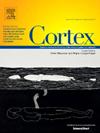Cognitive neuropsychological and neuroanatomic predictors of naturalistic action performance in left hemisphere stroke: A retrospective analysis
IF 3.2
2区 心理学
Q1 BEHAVIORAL SCIENCES
引用次数: 0
Abstract
Individuals who have experienced a left hemisphere cerebrovascular accident (LCVA) have been shown to make errors in naturalistic action tasks designed to assess the ability to perform everyday activities such as preparing a cup of coffee. Naturalistic action errors in this population are often attributed to limb apraxia, a common deficit in the representation and performance of object-related actions. However, naturalistic action impairments are also observed in right hemisphere stroke and traumatic brain injury, populations infrequently associated with apraxia, and errors across all these populations are influenced by overall severity. Based on these and other data, an alternative (though not mutually exclusive) account is that naturalistic action errors in individuals with LCVA are also a consequence of deficits in general attentional resource availability or allocation. In this study, we conducted a retrospective analysis of data from a group of 51 individuals with LCVA who had completed a test of naturalistic action, along with a battery of tests assessing praxis, attention allocation and control, reasoning, and language abilities to determine which of these capacities contribute uniquely to naturalistic action impairments. Using a regularized regression method, we found that naturalistic action impairments are predicted by both praxis deficits (hand posture sequencing and gesture recognition), as well as attention allocation and control deficits (orienting and dividing attention), along with language comprehension ability and age. Using support vector regression-lesion symptom mapping, we demonstrated that naturalistic action impairments are associated with lesions to posterior middle temporal gyrus and anterior inferior parietal lobule regions known to be implicated in praxis; as well the middle frontal gyrus that has been implicated in both praxis and attention allocation and control. Together, these findings support the hypothesis that naturalistic action impairments in people with LCVA are a consequence of apraxia as well as deficits in attention allocation and control.
左脑卒中自然动作表现的认知神经心理学和神经解剖学预测因素:回顾性分析
经历过左半球脑血管事故(LCVA)的人在评估日常活动能力(如准备一杯咖啡)的自然行为任务中会犯错误。这一人群的自然行为错误通常归因于肢体失用症,这是一种与物体相关的行为的表征和表现的常见缺陷。然而,在右半球中风和创伤性脑损伤人群中也观察到自然行为障碍,这些人群很少与失用症相关,所有这些人群的错误都受到总体严重程度的影响。基于这些和其他数据,另一种解释(尽管不是相互排斥的)是LCVA个体的自然行为错误也是一般注意力资源可用性或分配缺陷的结果。在这项研究中,我们对51名LCVA患者的数据进行了回顾性分析,这些患者完成了自然主义行为测试,以及一系列评估实践、注意力分配和控制、推理和语言能力的测试,以确定哪些能力是导致自然主义行为障碍的唯一原因。使用正则化回归方法,我们发现自然行为障碍可以通过实践缺陷(手部姿势排序和手势识别)、注意力分配和控制缺陷(定向和分散注意力)以及语言理解能力和年龄来预测。使用支持向量回归-病变症状映射,我们证明了自然行为障碍与已知与实践有关的后颞中回和顶叶前下小叶区域的病变有关;额叶中回也与实践,注意力分配和控制有关。总之,这些发现支持了一个假设,即LCVA患者的自然行为障碍是失用症以及注意力分配和控制缺陷的结果。
本文章由计算机程序翻译,如有差异,请以英文原文为准。
求助全文
约1分钟内获得全文
求助全文
来源期刊

Cortex
医学-行为科学
CiteScore
7.00
自引率
5.60%
发文量
250
审稿时长
74 days
期刊介绍:
CORTEX is an international journal devoted to the study of cognition and of the relationship between the nervous system and mental processes, particularly as these are reflected in the behaviour of patients with acquired brain lesions, normal volunteers, children with typical and atypical development, and in the activation of brain regions and systems as recorded by functional neuroimaging techniques. It was founded in 1964 by Ennio De Renzi.
 求助内容:
求助内容: 应助结果提醒方式:
应助结果提醒方式:


